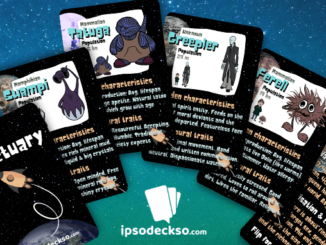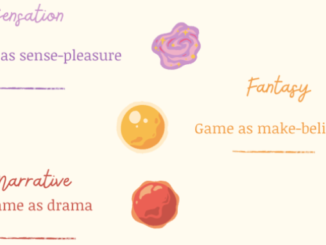
What is the Museum?
The Museum of Impossible Objects is a ‘game’ consisting of a set of cards, each with an image, a label, as if the image were a museum exhibit, and a set of questions, to prompt further reflection.
The Museum of Impossible Objects is available on Deckible
As a game, The Museum lacks several components that one might expect. It has no rulebook, and is definitely very light on mechanics. The whole thing is very self-referential, in that clues are scattered among the cards themselves about the premise of the ‘game’, which in turn might give players ideas about how to play.
I have decided to write this article, partially because I hope people will find it useful, and that it may inspire the design of similar games, but also because my design process was a form of ‘play’ itself, which may give learning facilitators, who come to use the cards, ideas as to how they might use them.
Creating the Museum was itself a form of play
The process of creating the cards had a lot in common with the way I expect people will use them to play – responding to the images with stories and ideas of their own. The images definitely came first, and my response to the images suggested the text, and indeed the idea of the Museum itself.
The Museum would probably not have come into being at all if it had not been for a LinkedIn post (I forget whose, sorry) containing an image generated using Midjourney AI. I immediately began playing with Midjourney, and as a body of decidedly weird work started to emerge, so did ideas about how those might work as a ‘game’ utilising cards.

While many of the images were pretty strange, they did actually remind me of objects I had seen in real life, in the drawers and glass cases of the decidedly magical Pitt Rivers Museum in Oxford. I began to look back at the images created and devise labels for them. And as each new image emerged it suggested new ideas.
I had created about half of the cards in the deck, when I started to get a bit more ‘intentional’. I thought I had grokked how Midjourney was ‘thinking’ and started to reverse my process – thinking of the label idea first, and then trying to create the image to go with it.
Deliberate intent was not as effective as play
In practice, this proved to be much less satisfactory, than when I had simply been ‘playing’. The ideas seemed more forced, and indeed it became frustrating to try to get Midjourney to create a suitable image to accompany the text I had already written. This was the result of a combination of my own lack of experience and skills in using Midjourney and the capabilities of the tool at the time.
But I am glad that this happened. I feel that if I had started my (Mid)journey now, with the realism of the V4 algorithm, I would not have achieved many of the stranger images, or the flights of creative imagination which they prompted.
I soon reverted to the original method of creating images first. This was of course, not totally without direction. I was feeding Midjourney with the more weird and wonderful aspects of my interests – H.P. Lovecraft, Fae lore, ghost stories, magic, sacred geometry, Victorian and gothic art and literature and so on, but I was not trying to be specific about the images. I made a conscious decision to be ‘happy’ with the images that resulted and to adapt the labels to fit them – finding creative ways to explain the distortions and oddities of the pictures.

Making a virtue of the flaws
An example of this was the image of the ‘Spacebender Moth’. The prompt was simply ’a moth with arcane markings on its wings’. The resultant image displayed, as much output from MJ did at that time, considerable distortion. The best option seemed to be to make the distortion the point of the image, and the idea of a moth whose defining characteristic was an ability to bend reality, arrived.

The same principle was applied to the painting by ‘Hans Holbein’, which was an especially satisfying idea as it was so appropriate thematically. A well-known tenet of fae lore is that fae folk confuse mortals’ gaze and thoughts through ‘glamour’, and that fitted really well with the idea that an artist could both paint a picture that was so confused, and also that he would not remember doing so.
Coming across Midjourney seemed serendipitous, but there was also another piece of technology that was occupying my time and thoughts at the same time. I had just uploaded a card-based version of The Gift Horse to Deckible, an app which is to card decks what Audible is to audiobooks, so when I decided to create the Museum cards, I naturally decided to create the cards for the Deckible format.
Three-sided cards
This meant one important thing. Because Deckible is an app, card decks on it do not have the same physical constraints that cards have in real life. The Museum cards are three-sided, having a back and two ‘fronts’.
It was this second front that allowed me to create something that moved beyond being a set of writing prompts – which was my first intention for the deck, to something with more learning potential.
I have always been interested in the way that speculative fiction – science fiction, fantasy, magical realism and even horror, allows us a way to more deeply reflect on what it is to be human.
It both opens up consideration what might be possible, and holds up a mirror to our behaviours, beliefs, values and foibles. As it does this, it seems to be capable of simultaneously making us uncomfortable, by asking the questions, but also more comfortable about answering them, because there is a layer of remove, when we are considering them.
When stories get serious
For example, I remember watching, when I was quite young, an episode of Star Trek where there was a bitter war being waged between two different peoples on the same planet (Let That Be Your Last Battlefield SE03 Ep15 TOS). All the inhabitants have faces that are half black and half white, except one half are right-white and left-black and in the other half of the population the colours are reversed.
It was the first time that I became aware that my favourite genres of entertainment were also capable of talking about serious topics – in this case, racism and slavery.
So, while the Museum cards can just be used as writing prompts in various (mostly weird fiction), genres, they can also be ‘turned over’ to look at questions which might open up more interesting and reflective discussions.
The Museum of Impossible Objects is available on Deckible
The Museum as a Learning tool
The Museum of Impossible Objects can therefore be used in learning settings in Education, from secondary school to higher education, and in workplace learning. Potential applications include:
- Educational ‘classroom’ settings
- Writing prompts in Literature and Drama education
- Critical thinking
- Philosophy and Ethics
- Workplace and organisational learning
- Organisational storytelling for vision, mission and discovery
- Futures Thinking
- Sustainability and Business Ethics
- Diversity and Inclusion
- Innovation and Creativity
It can also be played – just for fun. While many of the cards are likely to prompt quite serious discussions, and some of the questions have been specifically designed to do so, there are some ‘fun’ bits too. Can you imagine working in a place where the first rule in the Employee Handbook is ‘Do not eat the Goblin Fruit’ or where you had to contemplate the challenges inherent in operating a craft business in a premises outside of time and space.
So how would you play?
Many games present players with a story, but the premise behind the museum is different. There are no stories, but inside the cards, there is the potential for a literally infinite number of different stories.
The Museum of Impossible Objects is an exercise in Worldbuilding. There are glimpses of the artefacts that exist in the world, and the background behind those objects. But none of those is large enough or developed enough to qualify as a story. It is up to the players to create those as they play.
In reality, as I have hinted already, it is also up to the players to decide how the ‘game’ is played at all – if indeed it is a game. There is no rule book. While all games are an exercise in co-creation (of play experience) between designers and players, this one invites the players to design the game(s) as well.
With no rulebook, even the premise of the game is hidden within the cards themselves.

The Book of Exhibits is both an exhibit itself, and an explanation of the experience one has interacting with the cards. The questions on the (second) front of the cards are ‘put into’ visitors heads by the book, utilising the Museum’s psychic field. The book (if only we were able to peek inside) contains the answers (from the visitors’ imaginations presumably) in story form. And we are also told that it is very possible that the labels one sees on the exhibits are sometimes rewritten, based on these stories.
Learning from The Book of Exhibits
And just these few simple sentence gives us an immediate insight into how the cards might be used in a learning setting. There is so much to unpack, which could be used to reflect on, for example:
- Where collective ideas from and who or what puts them there
- The influence of mass media or social media
- Who or what ‘writes’ the stories that we all believe, and whether those remain constant
- The harvesting of data/insights by tech companies and how they use these to reflect back to us what we want to see
- The mutability of ‘truth’
- Etc.
And while these ideas can be pulled from the image and the label, turning each card over will reveal the questions, opening up more scope, or providing an easy route for educators to open conversation / storytelling without having themselves to prompt the learners.

‘Bottom Up’ Worldbuilding
The text, images and question represent an exercise in ‘bottom up’ worldbuilding, which is a practice whereby very granular aspects (artefacts) of a world (of which museum exhibits is a typical example) are used to provide a glimpse into that world. Broader aspects of the world; culture, politics, customs and manners, history – can then be extrapolated from these in the form of stories.
It works by inviting the storyteller:
“If there is a world in which this is true, then what else is necessarily / possibly true?”
(whatever the ‘this’ is that is demonstrated by the artefact).
As I mentioned the genesis of the idea for the Museum, occurred almost by accident, but once the idea was there, I was quite clear that I wanted to include certain particular ‘thises’ in the world of the Museum – because of the value they would bring from a learning perspective – and the kinds of issues they could address – albeit through a speculative fiction lens.
Accepting the premise of the world of the game and agreeing to play as if these things were true is an example of stepping into the Magic Circle of the game.

Without (hopefully) giving too much away the following are things that are true in the world of the Museum:
- Humans are not the only sentient species – and other sentient species, which include magical beings, have been involved in planetary decision making
- Magic and technology exist side by side, and have been combined to create innovations
- There is controversy around what should be exhibited in museums and where items come from
- Ghosts and demons exist, and can be a nuisance, requiring disposal or control, but are also, (somewhat inconveniently if you are looking to detain or destroy them), most likely sentient.
- Crows practise a shamanic religion
- Events do not always happens in the order you would expect them to, given our current understanding of cause and effect
- Etc.
So, what might ‘playing the game’ look like in practice?
It is not my place to prescribe the ways in which the game should be played. It is up to the players, and no doubt new ways to play will be discovered all the time – both ‘just for fun’ and in learning settings. But here are a few ways I have discovered so far.
- Revealing cards one at a time as if you were walking around the museum – and telling the story of that day / visit as you go.
- Using a single card as a focus for discussion / activities, such as writing prompts in a Literature class or a debate in an Ethics class
- ‘What If’ activities in which new cards / artifacts / social systems are extrapolated from a card or cards
- Competitive storytelling, where cards are collected by those telling the ‘best’ story about them (with or without a target context)

I hope that you feel inspired to either visit the Museum, or to create your own similar decks/games. Find new ways to play, invent your own additional questions – even create your own cards.
There is a whole magical world inside and outside the Museum’s door, just waiting to be discovered.
The Museum of Impossible Objects is available on Deckible
- James Bore – The Ransomeware Game - 13th February 2024
- Ipsodeckso – Risky Business - 23rd January 2024
- Review – Luma World Games - 15th December 2023





Be the first to comment